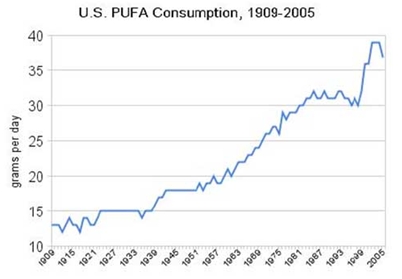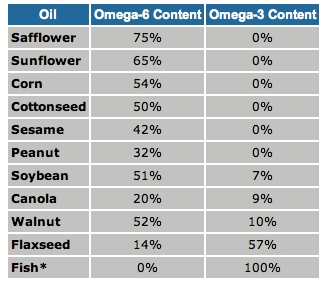The commonly accepted ideal ratio between omega 6 and omega 3 fats polyunsaturated fatty acids (PUFA) is anywhere from a 1:1 to a 4:1 ratio. It is estimated that Americans in the late 1800’s and early part of the 20th century had those kinds of ratios. Not anymore. The estimates are that now the ratio is more like 20:1 and up to 50:1. This ratio has been rising steadily since the beginning of the industrial age when grains became more of a source of feed for domestic livestock. This is depicted in the graph below.

Joseph Hibbeln, a researcher at the National Institute of Health (NIH) who has published papers on omega 3 and omega 6 intakes said the following.
“The increases of omega 6 oils in the past century may be considered a very large uncontrolled experiment that may have contributed to increased societal burdens of aggression, depression and cardiovascular mortality”.

Packaged foods containing some of the above oils are skewing the normal ratios that we should have in our diets. Soybean oil is so prevalent in our diets that some estimate that the average American is getting 20% of their calories from soybean oil. The effects of the higher intake of omega 6 oils is one word, inflammation. Inflammation is associated with cardiovascular disease, type 2 diabetes, obesity, metabolic syndrome, irritable bowel syndrome, rheumatoid arthritis, eczema, asthma, cancer, psychiatric disorders, and autoimmune diseases. In a study by the Journal of the American College of Cardiology, decreasing omega 6 levels to a 4:1 ratio by replacing corn oil with olive and canola oil, resulted in a 70% decrease in mortality.
Getting balanced
A great source of omega 3 fats is pastured eggs. In 2007 Mother Earth News tested the nutritional value of pastured eggs from 14 different farms and compared it to the USDA standard conventional egg. This chart shows the comparisons. The results are clear. Pastured eggs are higher in every vitamin tested and Omega 3 fat, and lower in saturated fat and cholesterol. Another egg study from Australia in 2010 had almost the exact same findings.

There is no quicker way to reestablish normal omega 3 levels and to balance an imbalanced omega 6 and omega 3 ratio, than to take fish oil. Fish oil’s benefits come mainly from the two kinds of omega 3 fatty acids it contains: Eicosapentaenoic (EPA) and docosahexaenoic acid (DHA). Omega 3 fatty acids are also found in walnuts, flax seeds, chia seeds, hemp seeds etc. However, it is in a form called alpha linoleic acid (ALA) and needs to go through multiple steps to convert into EPA and DHA. Unlike herbivores that isn’t easy for humans to do. Two studies showed that hemp seed consumption only results in a 5-15% conversion of ALA to EPA and DHA. Additionally, some people have a genetic SNP (single nucleotide polymorphism) on the FADS2 enzyme (fatty acid desaturase 2 enzyme), that interferes with the conversion from ALA to EPA and DHA. This fault interferes with the delta-5-desaturase enzyme and delta-6-desaturase enzyme responsible to make the conversion. Vegans would be better off taking EPA and DHA from algae oil to bypass the conversion inefficiency that would likely exist from relying upon seeds and nuts to deliver adequate amounts of omega 3 fats.
Most fish oil is distilled and made from smaller fish such as anchovies or sardines. The better companies will do regular testing on the oils to certify that they are free of contaminants such as mercury and the fish oil won’t freeze when placed into a freezer. The difference between Cod Liver Oil and Fermented Cod Liver Oil, is unfermented cod liver oil is distilled just like regular fish oil. Fermented cod liver oil is aged by a natural fermentation process originating from a time before the Vikings, when Nordic people preserved the livers of the cod fish they caught in the arctic. Because it does not go through distillation, naturally occurring vitamin D, vitamin A and vitamin K2 remain in the fermented product. Regular cod liver oil if distilled, will lose those vitamins. Another type of fish oil is Krill oil. Krill is a small red colored crustacean like shrimp used by whales as a primary food source. The red color of krill is due to it’s being high in a carotenoid called astaxanthin. Anstaxanthin derived from the algae the krill eat is also present in salmon, and is considered a major antioxidant.
The various fish oils also have unique forms for the omega 3 fats. Regular distilled fish oil has its omega 3’s in an ethyl ester form. Fermented Cod liver oil has its omega 3’s in a natural triglyceride form and Krill oil has its omega 3’s in a water-soluble phospholipid form. As far as I can see all three forms have studies supporting advantages to each but there isn’t a clear overall advantage to one type. Personal experience with different types of fish oil might give its user a preference. It is also possible that like probiotics, it might be best to rotate fish oils to gain the benefits of all three types. However, if someone has an allergy to shellfish, krill oil will probably not be the best choice for them.
Check your ratio
If you are curious if your Omega 6/3 ratio is acceptable there are two labs that provide testing. Spectracell Laboratories has a test called the H-S Omega-3 index as part of its cardiovascular profile. Another lab, Genova Diagnostics has a Blood Spot Fatty Acid Profile that is much the same. Both tests are available in my office. If you would like to know more about this, please call the office and I can explain in more detail prices and insurance coverage.